Affiliate disclosure: This post may contain affiliate links. Please see our Privacy Policy.
Canning blueberries is a simple way to preserve blueberries for winter baking, or simply eating right out of the jar.
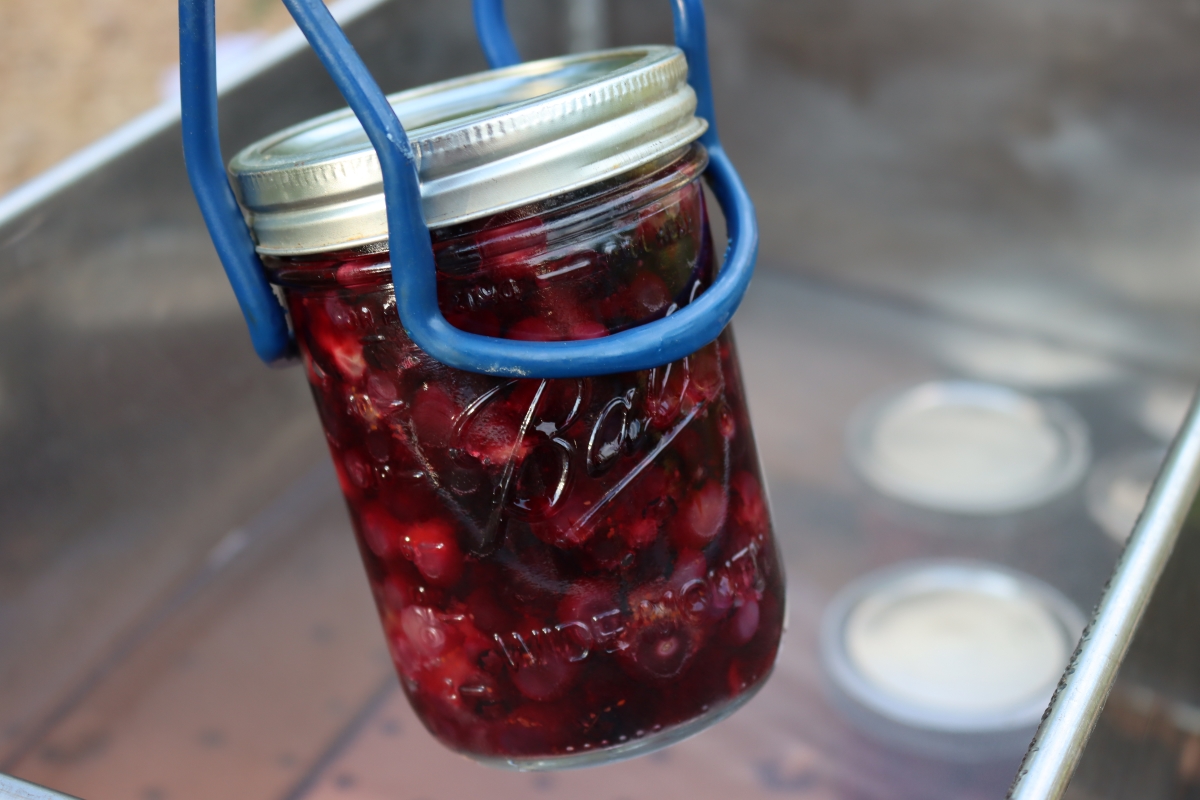
While freezing blueberries is one of the most common ways to preserve these summertime fruits, I actually prefer canning them, at least for some uses. I find that home-canned blueberries work better in baked goods, and since you’re baking the blueberries anyway, it doesn’t matter that they’re cooked in the canning process.
Canning blueberries also saves freezer space, and we’re always short on freezer space on our solar-powered homestead. We never seem to have enough freezer space, even with three chest freezers, two running DC electric right off the batteries, and a third overflow freezer on regular AC power.
This year things were especially tight as we bought a side of beef, which filled one whole freezer to the brim. I was happy I planned ahead and canned blueberries this year, which saved quite a bit of freezer space.
(Even still, I found myself canning beef that wouldn’t fit in the freezer!)
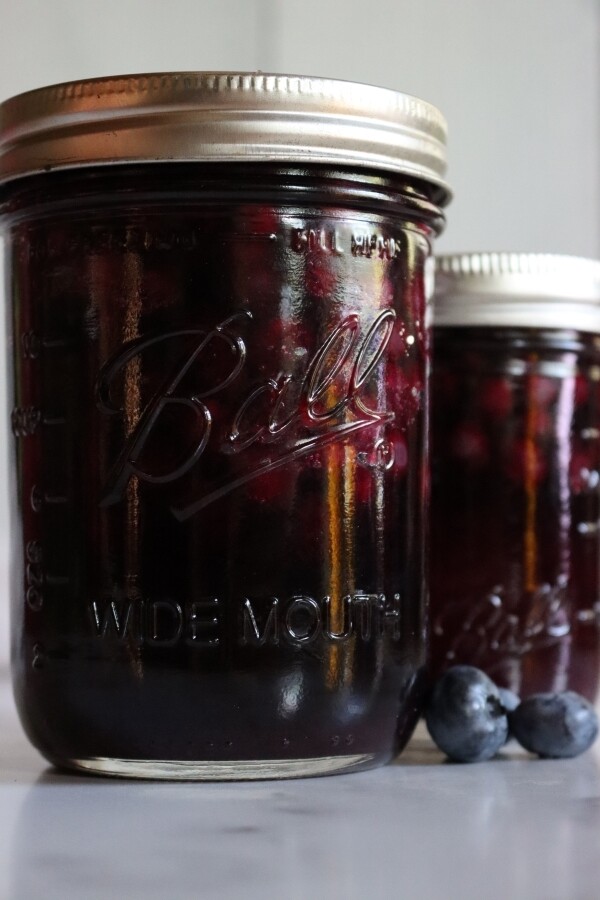
Selecting Blueberries for Canning
Choose blueberries that are intensely purple-blue or blue-black color for canning, the color of the berries is actually the best indicator of maturity. Blueberries that are tinged with light green or pale blue should be left alone, as they’re most likely still underripe. Blueberries that are firm, dry, and plump are generally best for eating; pick out any slimy or mushy berries as best you can when you’re prepping the fruit for canning.
We harvest blueberries every year beginning in June and continuing through until late September. When blueberries are perfectly ripe they should fall into the pail with very little (if any) effort at all. A simple tap should have cause the berries to fall off the plant, no blueberry wrangling needed!
Syrup for Canning Blueberries
Because blueberries are already acidic and naturally quite sweet, you can choose almost any kind of syrup as a canning liquid. I’ve seen recipes that call for water as a canning liquid, although having tried this method I think it dilutes the flavor of berries and don’t recommend it.
What I like to use instead is an extra light syrup, which matches the natural sweetness of the blueberries. Without a bit of sugar, the berries will leach sweetness and flavor into the canning liquid, so I add just enough to maintain the flavor or the berries (but not sugar them up).
I make extra light syrup with 3/4 cups sugar and 6 1/2 cups water (for a 9-pint canner load), or 1 1/4 cups sugar to 10 1/2 cups water (for a 7-quart canner load).
Depending on how sweet you like your blueberries, you can give one of these suggestions a try:
- Light syrup adds a touch more sweetness without overwhelming the flavor of the blueberries. For a 9-pint canner load, use 1 1/2 cups sugar and 5 3/4 cups of water; for a 7-quart canner load you’ll need 2 1/4 cups sugar to 9 cups of water.
- Medium syrup will produce sweet fruit that tastes decadent, especially when adding to dessert recipes. For a 9-pint canner load combine 2 1/4 cups sugar with 5 1/4 cups water; for a 7-quart canning load use 3 3/4 cups sugar to 8 1/4 cups water.
- Blueberry syrup is another option for canning and can be made using the method I’ve outlined in my post about canning blackberries (or, if you have one, you can use a steam juicer to speed up the process). This option takes a little bit longer, but it means you’ll get to enjoy the syrup in drinks, drizzled your favorite desserts, and in salad dressings.
- Fruit juice is a good option if you’re avoiding refined sugar but still want a hint of sweetness. Blueberry, apple, and white grape are all good options and they won’t mask the flavor of the finished berries.
If you’re not sure how to choose a canning liquid, remember you can always make a small test batch before committing to the complete recipe.
How to Can Blueberries
There are a number of options when canning blueberries at home. You can do a hot pack or raw pack, and they can be processed in either a water bath or pressure canner.
In my opinion, the best results come from hot packing and then water bath canning, but I’ll take you through all the options.
For this canned blueberry recipe, you’ll need 8 pounds of blueberries per canner load of 9 pints or 12 pounds of blueberries per canner load of 7 quarts (this is assuming 1 3/4 pounds of berries is roughly equivalent to one quart of preserves).
Raw Pack
Raw packing is a canning technique where the jars are filled with fresh, unprepared blueberries and hot liquid, no cooking of the fruit is required. This is the easiest, least time-consuming method for filling jars, but it does have a couple of disadvantages. Namely, the berries will float to the top of the canning liquid and they’ll be more susceptible to discoloration after a few months of storage (although they’ll still be perfectly tasty and safe-to-eat if they happen to turn brown).
Prepare a water bath canner or pressure canner, jars, and two-piece lids (this recipe makes 9 pints or 7 quarts).
Depending on the canning liquid you’ve chosen, bring the water and sugar, blueberry syrup, or fruit juice to a boil in a large saucepan.
Fill each still-warm jar with raw blueberries, carefully shaking the berries so they settle into the jar in the most space-maximizing way possible. Keep an eye out for any missed stems, leaves, or underripe (or overripe) berries, removing them as you work.
Cover the blueberries with hot canning liquid, leaving 1/2-inch of headspace between the top of the liquid and the lid of the jar. Use a nonmetallic utensil, such as a plastic knife or wooden chopstick, to remove any air bubbles. Adjust lids until finger tight (as in, not so tight you need to make much of an effort to screw or unscrew the ring).
Once the lids have been sealed, the raw-packed blueberries are ready to be processed in a hot water canner or a pressure canner.
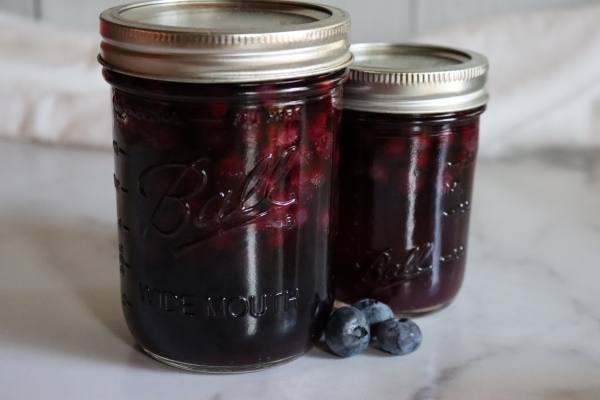
Hot Pack
The hot pack method is my go-to technique when I can blueberries, it only takes a few extra minutes and the results are free from floating fruit and I know the berries won’t change color after a couple of months of storage. A short dip in boiling water blanches the blueberries, which prevents them from shrinking in the jars after being processed in the canner.
Heat your choice of canning liquid in a large saucepan until boiling. At the same time, bring another large pot of water to boil, adding the blueberries directly to the water when it has reached a rolling boil. Let the water and blueberries return to a boil and set the timer for 30 seconds. When the timer goes off, drain the blueberries in a colander or large sieve.
Pack each jar with hot blueberries and cover with the still-hot canning liquid, leaving 1/2-inch of headspace. Remove any remaining air bubbles before sealing each jar with the lid and ring. Now the hot-packed blueberries are ready to be processed in a hot water or pressure canner.
I’m working in my outdoor canning kitchen, which I’ve set up in the blueberry patch. I run a high output propane burner and my high capacity Amish canner for the actual canning, and heat the blueberries in a small Coleman stove before packing them into jars. That way, the house stays cool and I get to enjoy the sunshine!
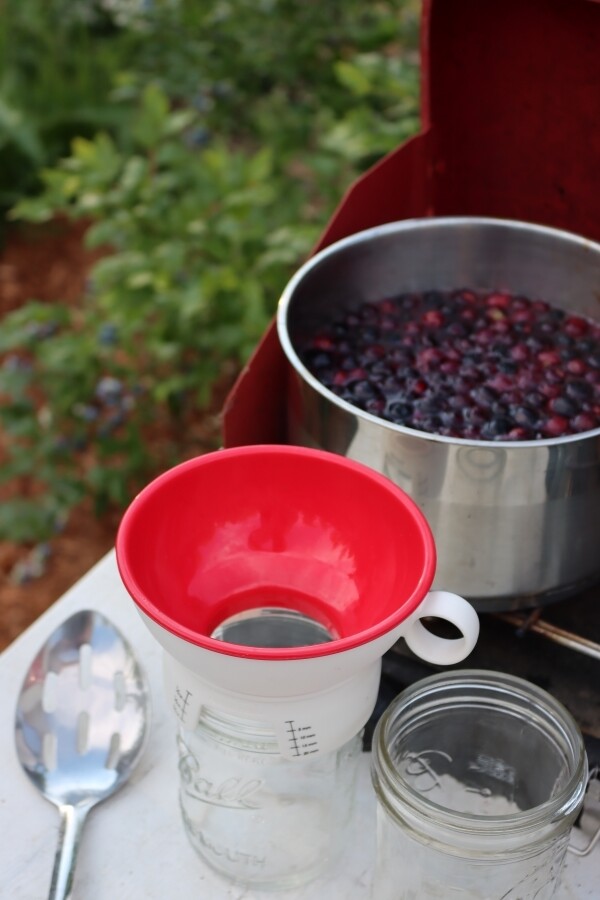
Headspace for Canning Blueberries
Whether you plan on using a hot water bath canner or a pressure canner, you should always leave 1/2-inch of headspace when canning blueberries. This guide to making blueberry preserves from the Bernardin website recommends filling the jars up with blueberries 3/4s of an inch from the top and then finishing with canning liquid until it reaches a 1/2-inch from the underside of the lid. That’s rather specific, but it ensures that the canning liquid is over the berries, preventing discoloration (at least with a hot pack).
In the US, canning guides are less specific, and just suggest 1/2 inch of headspace. That works fine, the berries will still shrink a bit in the canner, even with a hot pack. That means there’s still enough liquid to cover them even if you’ve used 1/2 inch as headspace for both berries and liquid.
I use a canning funnel with headspace measurements on it, which makes it really easy.
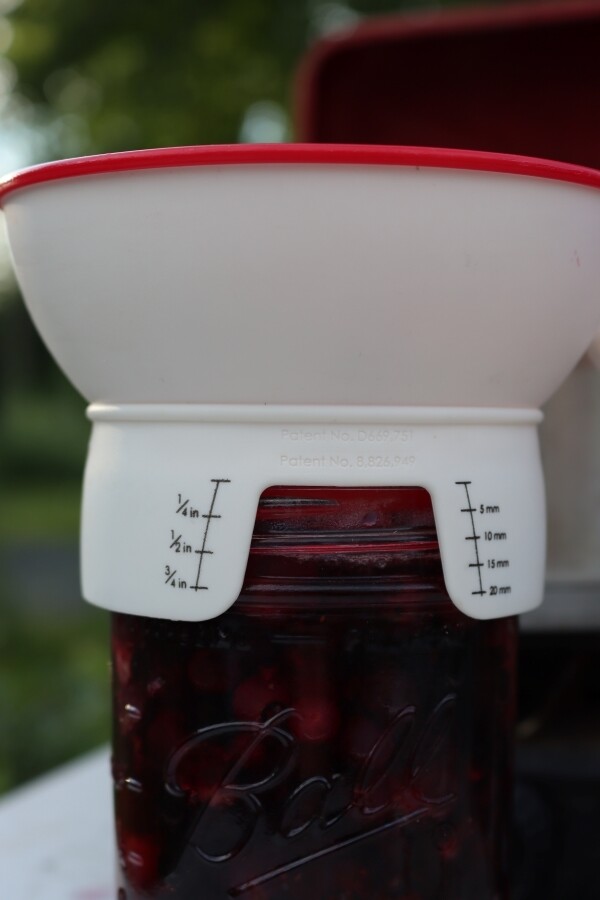
Water Bath Canning Blueberries
If you’re new to canning or need a refresher, I’d highly recommend reading up on the process before you begin. My beginner’s guide to water bath canning is full of all the tips and tricks you need to ensure the results of your home-canning endeavors are as delicious as they are safe for potential long-term storage.
When you’ve chosen either a raw- or hot-packing method, the jars have been filled, and the two-piece lids tightened, the jars are ready to load into the boiling water canner. Using a clean cloth, wipe away any blueberries or syrup that might have splashed onto the outside of the glass while it was being filled. Make sure that the loaded jars are covered by at least one inch of water, only setting the timer once the canner water has returned to a boil.
The table below lists processing times for both pints and quarts, as you can see it doesn’t take too long to can blueberries, even at higher altitudes where it’s necessary to increase the times since water boils at a lower temperature at higher elevations.
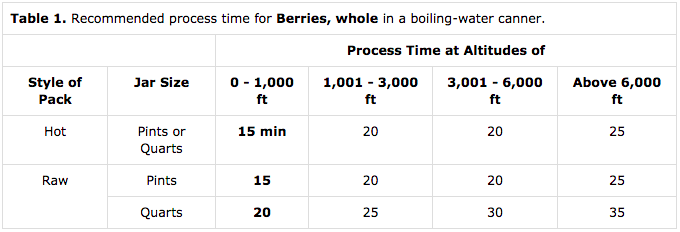
After the processing time is finished, remove the lid of the water canner and let the jars sit in the hot water for 5 minutes before removing them with a jar lifter. Being mindful of tilting or excess movement, place the jars on a clean towel, leaving at least one inch of space between each jar.
Give the canned blueberries 24 hours to come to room temperature, at which it’s time to check if all the lids have sealed. You’ll be able to tell if the seal is successful by pressing on the lid, it should curve slightly downwards and won’t move when pressed. If any of the lids haven’t sealed, transfer the preserves to the fridge and enjoy within the next 3 to 4 days. For the jars with sealed lids, remove the rings and store them for future canning projects.
Label the blueberries with the contents of the jar and the date, keep them stored in a cool, dry place away from light and temperature fluctuations. Blueberries that have been properly canned will keep for up to 18 months.
Pressure Canning Blueberries
I prefer the water bath canning method for blueberries since it’s already such a short processing time, but if you have a pressure canner you can definitely use it for canning blueberries. Once you get a feel for pressure canning, it’s pretty much smooth sailing from there — but for a beginner, the whole canning ordeal might seem intimidating. If pressure canning for the first time, check out my comprehensive, super-detailed guide to pressure canning with both dial-gauge and weighted-gauge pressure canners.
Prepare the blueberries in jars as outlined above, applying the lids and rings until fingertight, and wiping the sides of the jars down to remove any accidentally spilled food. Load the canning jars into the pressure canner, the charts below show processing times for both a dial-gauge pressure canner and a weighted-gauge pressure canner, and cap up the lid.
Allow the steam inside the pressure canner to build for 10 minutes, the chamber needs to be full of steam before the canner can be brought up to pressure. When the correct PSI has been reached, you can start the timer. As you can see, the processing times and pressure needs to be adjusted depending on the altitude at which you’re canning.
Turn off the heat as soon as the timer goes off and let the pressure canner come back to room temperature and 0 PSI before removing the processed jars to check whether lids are sealed and to be labeled for storage.
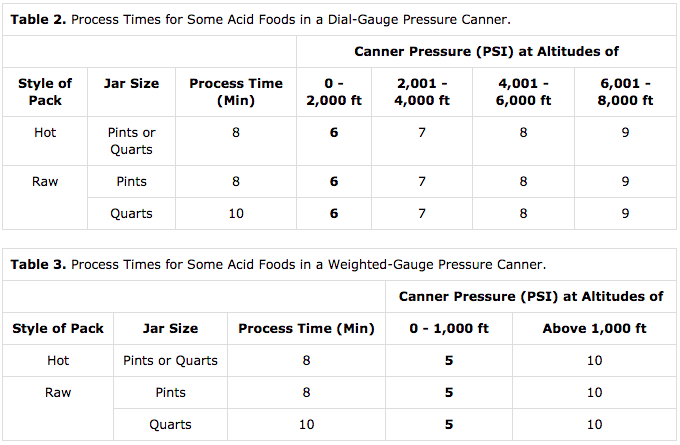
Using Canned Blueberries
Use canned, drained blueberries in place of fresh or frozen in muffins, quick bread, pancakes, and other baked goods. During the summer months, I make a blueberry vinaigrette and use it to dress green salads or serve alongside grilled chicken or fish. When pork or venison is on the menu, I like to whip up this tangy blueberry chutney using canned blueberries instead of fresh.
Don’t get rid of the syrup, either, as it has a long list of culinary uses. Cocktails are a natural fit for blueberry syrup, particularly in drinks on the effervescent side; a blueberry whiskey spritzer or blueberry gin fiz is one the best uses of blueberry syrup I can think of.
I also like to make a refreshing non-alcoholic spritzer by pouring the syrup over ice and adding regular or fizzy water, garnishing with fresh mint or basil leaves.
Blueberry syrup can also be used to make homemade blueberry jelly, it can be drizzled over ice cream and frozen yogurt, and it makes a great base for homemade popsicles. And speaking of frozen treats, you can portion out blueberry syrup in an ice cube tray, transfer it to a freezer-safe container, and then keep the syrup in a resealable container in the freezer for up to a year.
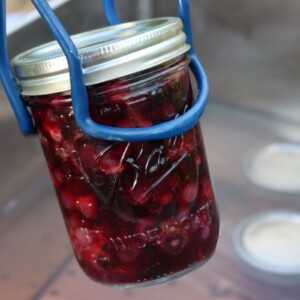
Canning Blueberries
Ingredients
- Blueberries*
- Sugar**
- Water**
Instructions
- Carefully wash blueberries in cold water, working with a quart or two of berries at time. Drain the berries, removing any spoiled berries, stems, and leaves as you work.
- Prepare a water bath canner or pressure canner, jars, and two-piece lids.
- To prepare extra light syrup, combine sugar and sugar in a large stockpot in the amounts called for below. For a sweeter syrup refer to the table listed in the notes; blueberry syrup, fruit juice, and water may be substituted.
- Bring the canning liquid to a boil. Carefully ladle 1/2 cup of hot syrup/canning liquid into each prepared jar.
- For a raw pack: Fill each jar with blueberries, gently shaking the blueberries so they fill the jar out evenly. Cover the berries with hot syrup, leaving 1/2-inch headspace between the top of the liquid and the bottom of the lid. Wipe the outside of the jars clean. Apply and adjust the lids until fingertight. Load into a water bath canner and process for 15 minutes (pints and quarts). For canning times at higher altitudes, or if you’re using a pressure canner, see the notes section below.
- For a hot pack: Bring a large pot of water to boil. When the water is boiling, immerse the blueberries in the water. Wait until the water is boiling again before setting a timer for 30 seconds. Drain the berries when the time is up. Fill prepared jars with blanched blueberries and cover with hot syrup or other canning liquid, leaving 1/2-inch headspace between the liquid and the lid. Wipe the outside of the jars clean. Apply and adjust the lids until fingertight. Load into a water bath canner and process for 15 minutes (pints) or 20 minutes (quarts). For canning times at higher altitudes, or if you’re using a pressure canner, see the notes below.
- Allow the processed jars to sit in the hot water bath canner for 5 minutes before removing with a jar lifter. If using a pressure canner, turn off the heat and let the water come to room temperature (and the pressure to 0) before removing the jars.
- Set the jars on a clean towel or drying rack, making sure there’s at least one inch of space around each jar. Let the jars sit for 24 hours before checking the seal on each lid (refrigerate any jar without a proper seal), label, and store in a cool, dark, dry place for up to 18 months.
Notes
- For a 7-quart canner batch, mix 10 1/2 cups water and 1 1/4 cup sugar.
- For a 9-pint canner batch, mix 6 1/2 cups water and 3/4 cups sugar.
- 1,001–6,000 feet – 20 minutes; above 6,000 – 25 minutes
- 1,001–6,000 feet – 20 minutes; above 6,000 – 25 minutes
- 1,001–3,000 feet – 25 minutes; 3,001–6,000 feet – 30 minutes; above 6,000 – 35 minutes
- Processing time is 8 minutes; 0–2,000 feet – 6 PSI, 2,001–4,000 feet – 7 PSI; 4,001–6,000 feet – 8 PSI; 6,001–8,000 feet – 9 PSI
- Processing time is 10 minutes; 0–2,000 feet – 6 PSI, 2,001–4,000 feet – 7 PSI; 4,001–6,000 feet – 8 PSI; 6,001–8,000 feet – 9 PSI
- Processing time is 8 minutes; 0–1,000 feet – 5 PSI; above 1,000 feet – 10 PSI
- Processing time is 10 minutes; 0–1,000 feet – 5 PSI; above 1,000 feet – 10 PSI
Summer Canning Recipes
Looking for more easy summer canning recipes to put up the harvest?
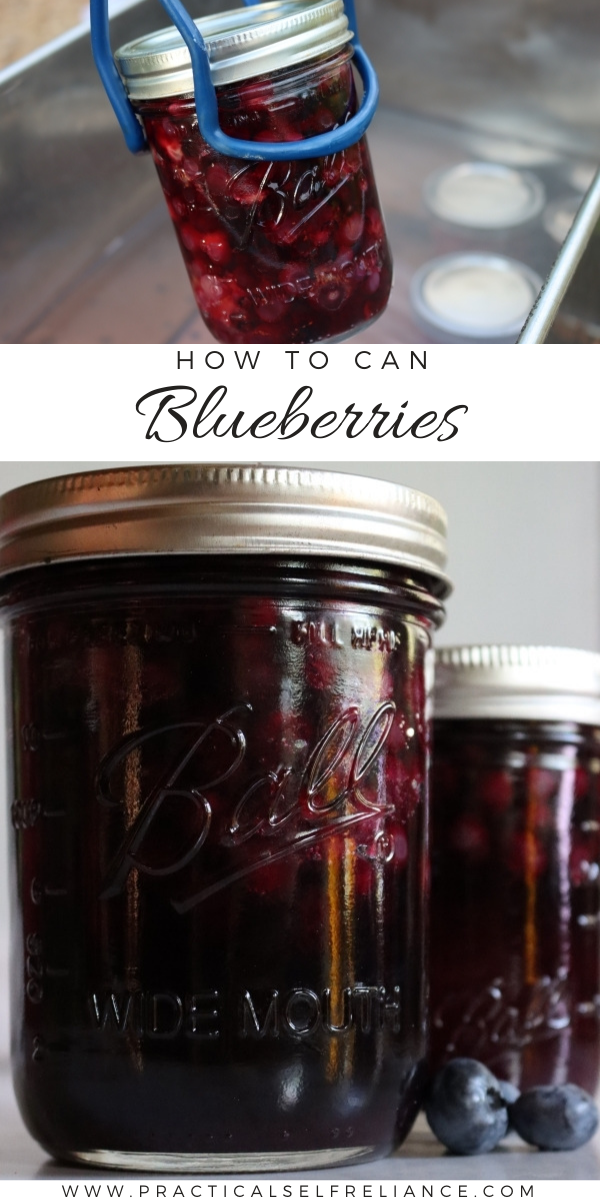
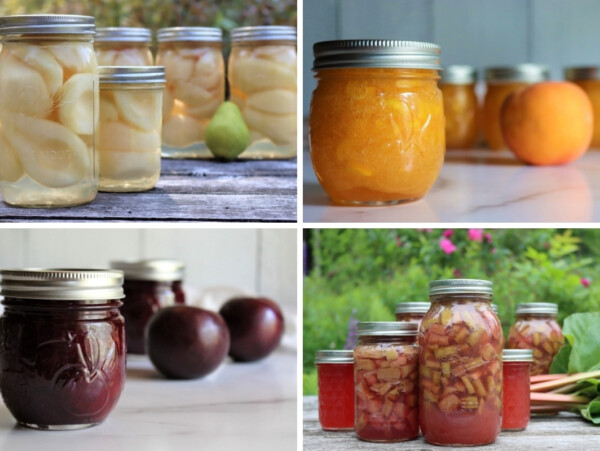
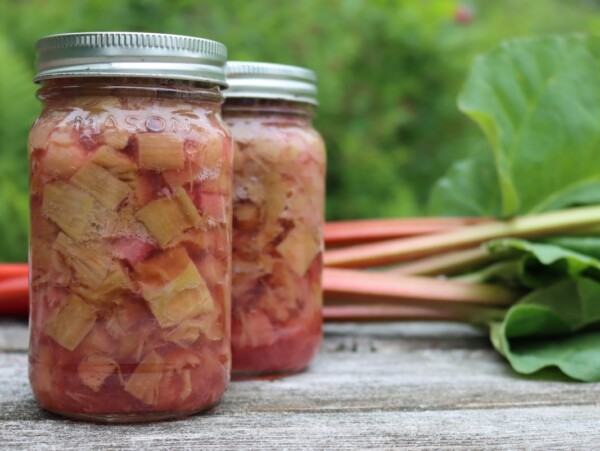
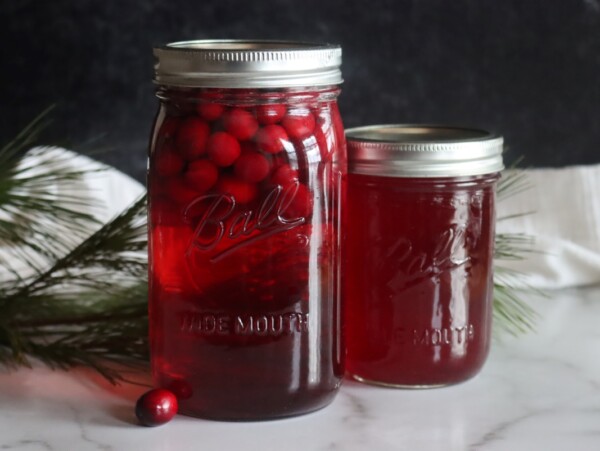
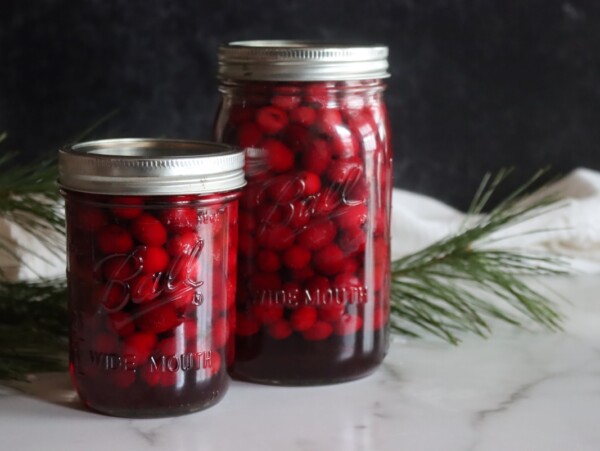
I have never canned, and my 40 bushes are starting to ripen. Usually, I have tons of friends help pick, but this year, I thought I might attempt canning. I won’t care if the berries turn to mush because I will use them mixed with yogurt or cottage cheese for breakfast. My question is if there is a reason why I shouldn’t just dip a colander of berries into the sugar water that will fill the jars rather than a separate pot of water. I’d like to keep all of the vitamin goodness that I can, and it seems like I’d be dumping out a lot if I used a separate pot of water.
Yup, you can do it in the same water.
Would I be able to do this with frozen blueberries as well ? That’s all I have right now .
Yes, you can do it with frozen blueberries, but they will break apart in the cannning process. Those are better used for juice, jelly or jam.
There is an error in the instructions.
I followed too a T and ended up with 9 lbs of mush.
So disappointed after all that work picking and money invested etc…
After investigation you do NOT, wait until the blueberries and water reach a boil again before timing 30 seconds.
Instead you only dip them into boiling water for a total of 30 seconds. Waiting for the water to reach a boil again cooks them. They lose color, flavor, shape, and it results into 9 lbs of berries fitting into 2 jars.
Girl, I always thought about blogging, even started once, but honestly couldn’t find the time. Your stuff is all amazing. I am always impressed with your content, accuracy and details. And great grammar. Thank you. I really want to learn about whether to pressure can or not these beauties, so I appreciate your opinion on the blueberries. Thanks again.
Thank you. We’re so glad you’re enjoying the posts. We prefer water bath canning blueberries but they can be processed in a pressure canner as well if you like.
Hi,
your blanche method here leads to berry mush no matter how ripe or unripe the berries were. Please fix the recipe. I have just wasted 8lbs of freshly picked blueberries because I followed your instructions to bring them to a full boil after adding them to the boiling water. Absolute disaster. I have to find some way how to use this mush now after pouring tons of good berry mush and juices down the drain when I drained them. What a waste.
I am so pleased to have discovered your extraordinary explantions and directions. Thank you from the centre of my heart.
I have preserved jams and jellies, however, not whole fruits. Your I successfully canned 12 jars of blueberries and hopefully the market tomorrow will have more to allow me to do at least another 4 kg.
Now the proof will be in the pudding. the jars successfully sealed and I will be providing a good friend some samples to try with a cheese cake recipe for the topping.
with fond regards, and much love
Theadore
You’re very welcome. So glad you enjoyed the post.
Hi Ashley, I had the same experience – the blueberries turned to mush in the boiling water – but then I just dipped the blueberries into the boiling water for about 15 seconds and they stayed round and lovely. The mushier ones will be delicious on ice cream, made into muffins etc. Thank you for the recipe. I enjoyed your site very much.
You’re very welcome. Thanks for sharing.
The absolute worst instructions for hot bath cannng blueberries, which wasted all the money on them and made them into much. These instructions are not good at all for hot pack blueberries as I see by others comments. Bring them to a boil again…really!! Why I trust some of the recipes… SMH.
I’m sorry that this method didn’t work well for you. This is actually the standard procedure for canning any kind of berry using the hot pack method. You may prefer to use the raw pack method instead.
My berries turned to MUSH not even blanching the 30 seconds. I couldn’t even let the water come back to a rolling boil. I’m afraid I’ve just wasted $30 of blueberries … I went ahead and canned them following the instructions but I’m worried it’s wasted effort.
I’m so sorry that happened. Do you think they were overripe?
Hello Dear Ashley,
I have been living and experiencing the self-sufficiency off-grid lifestyle for more than sixty years, so I accumulated some practical and technical knowledge that I would like to share and help others in the same philosophy of life.
By reading one of your articles on the solar system, you have been misled by the “new technology” that comes from the inexperienced gadget phantasist. Such that some fundamental electronic theories are totally wrong.
As the first example, the equalization of the battery voltage: the voltage controller has a program that cooks off the mineral accumulated on the plates… that is totally false! The controller is programmed to short circuit the batteries to bring them to zero volt then rebuild the charge in the concept that the batteries will be recharged evenly thereafter… that concept is erroneous; the batteries don’t accumulate mineral on the plates, the actual chemical reactions in the charging process create oxidation that precipitate at the bottom of the batteries which short-circuit the plates and this disintegration of the plates make them less efficient in charge accumulation as well. The quality control in the fabrication of the plates in the batteries has to do with the battery longevity and dropping the charge of the battery to zero causes more damage than benefit. The only way to correct the situation when the batteries have unequal voltage output, is to check which battery has a short-circuit in the internal cells and replace it by a good one. In the case of a short-circuited cell, there will be a surcharge to other cells. There is a method to check battery cells individually.
Also, there is no way to detect if a battery has reached its full charge capacity, no such device exists…So the charge controller cannot detect a full charge, as they pretend to prolong the battery life. As a conclusion, a battery charge controller is causing more damage to the batteries than would do any good. There are also those shunt type of controllers I won’t recommend.
I have designed a “voltage limiter” to regulate the voltage from the solar panels that works just perfectly and the most efficiently to prolong the battery life at its best.
I wonder who came with the ridiculous idea to mount the solar panels on roof top!!!
There is a way to install a submersible pump and reservoir that is easy on the system and does not overload…
I hope this will help anyone who is serious in the self-sufficiency lifestyle.
Hi! Have you tried these with maple syrup instead of sugar in the light syrup? I know it’s rebel canning to make substitutions……but logically uc blueberries are safe to can in just water……
Yup, you can definitely use maple or honey in the syrup instead of sugar, not rebel at all, that’s completely allowed by modern canning guidance. Maple and honey both taste sweeter than sugar, so I’d suggest using 3/4 as much. Enjoy!
I found my blueberries got mushy too when timing 30 seconds from when the water started boiling. I ended up using a metal colander with a handle and basically just dipping the blueberries into the boiling water for about 15 seconds or so, and then pulling them out. This also made it easier to drain them and not have excess water with them when I put them in the jars. My mother always did the raw pack method and I wanted to try this to see if it’s better. We’ll see the difference when I finally open a jar this winter! The only disadvantage was that I had to do them in smaller batches, but my colander holds about 2 quarts so it wasn’t that tedious. I just filled the jars with what I pulled out of the water, reloaded the colander, and repeated the process.
I tried your canning process for blueberries and I have no idea what I did wrong. I only cooked the berries for the 30 sec. but they turned into a jam like substance. Can you advise me on this? Warning, I am new at this and am trying to learn.
Were you using the hot pack method? If so can you describe to me step by step exactly what you did when you cooked the berries?
I have to say I had the same experience as Kathy did above. I was so careful to not leave the berries in the hot water more than 30 seconds. My water didn’t even come back up to a boil. Most of the berries just were mush coming out of the water and then going into the jars. I then spooned on the syrup and finished the process. They will be tasty and useable but certainly not even close to a whole berry